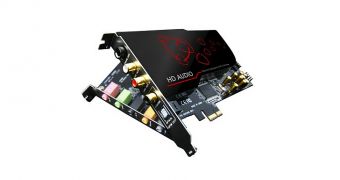Audio capabilities are an intrinsic part of motherboards these days, but none but the best, most overkill mainboards come close to audio studio-level sound quality, which is why products like the new SC808 exist.
Taiwan-based PC audio hardware manufacturer Aim has formally released the SC808 audio card, which is about twice as tall and thick as normal ones.
Sure, once upon a time, all sound cards were big, if not necessarily thick, but Aim really went out of its way to outfit the product with the best things it could find.
Granted, the actual sound card does not occupy the space normally reserved for a second PCI Express peripheral.
Which is to say, the newcomer doesn't have a super-thick cooler like high-end graphics cards. Instead, it uses a daughterboard.
That's the second curiosity: both the main sound card and the daughterboard plug into different PCI Express slots.
So you'll want to get a mainboard with at least two PCI Express 2.0 x1/x4 slots if you want to use it. It would be a waste to take up a PCI Express 3.0 slot (which only high-end video cards from NVIDIA and AMD can really use without wasting a lot of good bandwidth).
Anyway, the 7.1-channel dual-slot, full-height SC808 sound card is based on a native PCIe HDA (high definition audio) controller, the C-Media CMI8888.
You'd be amazed if you knew just how many motherboards, sound cards and audio playback devices use C-Media chips.
Also, the sound card has several analog outputs. The 2-channel headphone port, for instance, has a signal-to-noise ratio (SNR) of 128 dBA, thanks to a Wolfson WM8741 DAC.
The other analog channels (center/sub, sides, rear) use a C-Media CMI9882A CODEC, providing reasonable 100 dBA.
If all these technical numbers and terms fly over your head, it's fine. In layman terms, the new 7.1-channel sound card has the sort of traits that people who run sound studios will appreciate. Ergo, it's a very high-quality, high-end product that your PC probably doesn't need.
Not that game system owners and workstation builders will easily gloss over it if they run into it. Sure, the price of $112 / €81 isn't the best, but high-end customers aren't likely to care about the costs much anyway. Especially when the sound card has color-coded 3.5 mm jacks and solid-state capacitors for the VRM.
On that note, the only “drawback” is that electrolytic capacitors (less enduring and stable than solid ones) are used for everything else (except the OPAMP stages, which use MP caps).

 14 DAY TRIAL //
14 DAY TRIAL //